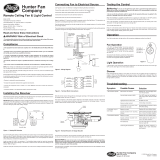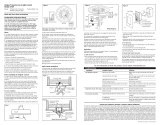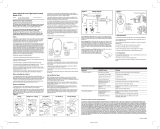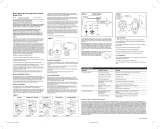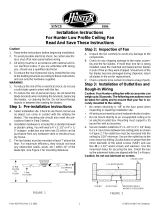Page is loading ...

Type 2A ModelsType 2A ModelsType 2A Models
Form# 42885-01
20100330
©2010 Hunter Fan Co.
For Your Records and
Warranty Assistance
For reference, also attach your receipt or a copy
of your receipt to the manual.
__________________________________________
Model Name
__________________________________________
Model No.
__________________________________________
Date Purchased
__________________________________________
Where Purchased
English Francias
Owner’s Guide and Installation Manual

2
42885-01 • 03/30/10 • Hunter Fan Company
Table Of Contents
Preparing the Fan Site . . . . . . . . . . . . . . . . . 3
1 • Getting Ready. . . . . . . . . . . . . . . . . . . . . . 6
2 • Installing the Hanger Bracket . . . . . . . 7
3 • Assembling and Hanging the Fan . . . 8
4 • Securing Fan to Secondary Support
System . . . . . . . . . . . . . . . . . . . . . . . . . . . . 9
5 • Wiring the Fan . . . . . . . . . . . . . . . . . . . . . 10
6 • Setting the Remote Transmitter and
Receiver. . . . . . . . . . . . . . . . . . . . . . . . . . . 11
7 • Installing the Motor Housing . . . . . . . 12
8 • Assembling the Blades. . . . . . . . . . . . . . 13
9 • Completing Your Installation With or
Without a Bowl Light Fixture . . . . . . 14
10 • Operating the Remote Control . . . . 18
11 • Operating and Cleaning Your Ceiling
Fan . . . . . . . . . . . . . . . . . . . . . . . . . . . . . . . 19
12 • Troubleshooting . . . . . . . . . . . . . . . . . . 20
© 2010 Hunter Fan Company
Your new Hunter
®
ceiling fan is an addition to your home or oce that
will provide comfort and performance for many years. is installation
and operation manual gives you complete instructions for installing
and operating your fan.
We are proud of our work. We appreciate the opportunity to supply
you with the best ceiling fan available anywhere in the world.
Before installing your fan, for your records and warranty assistance,
record information from the carton and Hunter nameplate label
(located on the top of the fan motor housing).
Cautions and Warnings
• READ THIS ENTIRE MANUAL CAREFULLY BEFORE BEGINNING
INSTALLATION. SAVE THESE INSTRUCTIONS.
• Use only Hunter replacement parts.
• To reduce the risk of personal injury, attach the fan directly to the
support structure of the building according to these instructions,
and use only the hardware supplied.
• To avoid possible electrical shock, before installing your fan,
disconnect the power by turning o the circuit breakers to the
outlet box and associated wall switch location. If you cannot lock
the circuit breakers in the o position, securely fasten a prominent
warning device, such as a tag, to the service panel.
• All wiring must be in accordance with national and local electrical
codes and ANSI/NFPA 70. If you are unfamiliar with wiring, use a
qualied electrician.
• To reduce the risk of personal injury, do not bend the blade
attachment system when installing, balancing, or cleaning the fan.
Never insert foreign objects between rotating fan blades.
• To reduce the risk of re, electrical shock, or motor damage, do not
use a solid-state speed control with this fan. Use only Hunter speed
controls.
Welcome

3
42885-01 • 03/30/10 • Hunter Fan Company
7’ Minimum
Blades to
Floor
30” From
Wall or
Nearest
Obstruction
Step 1 - Choose the Fan Site
Proper ceiling fan location and attachment to the building
structure are essential for safety, reliable operation, maximum
eciency, and energy savings.
Choose a fan site where:
• No object can come in contact with the rotating fan blades during
normal operation.
• e fan blades are at least 7 feet above the oor.
• e fan blades have no obstructions to airow, such as walls or
posts, within 30 inches of the fan blade tips.
• e fan is directly below a joist or support brace that will hold the
outlet box and the full weight of the fan.
Checklist for Existing Fan Site
If you want to use an existing fan site, complete the following checklist to
determine if the site is acceptable and safe for your new Hunter fan. If you
cannot check o every item, prepare a new fan site as described on this
page.
Fan Support System
• Fan attaches directly to building structure.
• Fan support system will hold full weight of the fan and light kit.
Ceiling Hole
• e outlet box clearance hole is directly below the joist or support brace.
Outlet Box
• e outlet box is an UL-approved octagonal 4” x 1-1/2” outlet box (or as
specied by the support brace manufacturer).
• e outlet box is secured to the joist or support brace by wood screws
and washers through the inner holes of outlet box.
• e outer holes of the outlet box are aligned with joist or support brace.
• e bottom of the outlet box is recessed a minimum of 1/16” into
ceiling.
Wiring
• e electrical cable is secured to outlet box by an approved connector.
• Six inches of lead wires extend from outlet box.
If your existing fan site is suitable, skip ahead to Section 2 • Installing the
Ceiling Plate.
Suitable Existing Fan Site
Fan Support
System
Fan Support
System
Wiring
Outlet Box
Preparing the Fan Site

4
42885-01 • 03/30/10 • Hunter Fan Company
Preparing the Fan Site (continued)
CAUTION: All wiring must be in
accordance with national and local
electrical codes and ANSI/NFPA 70. If
you are unfamiliar with wiring, use a
qualied electrician.
Steps 2 – 3
Step 4
Step 5
Step 2 - Cut the Ceiling Hole
2-1. Locate the site for the ceiling hole directly below the joist or support brace that
will hold the outlet box and fan.
2-2. Cut a 4” diameter hole through the drywall or plaster of the ceiling. You will use
the hole to install the support brace and outlet box.
Step 3 - Install a Support Brace, If Necessary
Determine if there is a ceiling joist directly above the ceiling hole. If the joist is there,
determine if it is positioned to allow you to recess the outlet box a minimum of
1/16” into the ceiling. If NOT, install a support brace as follows:
3-1. Attach a 2” x 4” support brace between two joists. Position it to allow you to
recess the bottom of the outlet box a minimum of 1/16” into the ceiling.
3-2. Check the support brace to ensure it will support the full weight of the fan and
light kit.
Step 4 - Install the Outlet Box
4-1. Obtain a UL-approved octagonal 4” x 1-1/2” outlet box, plus two #8 x 1-1/2”
wood screws and washers, available from any hardware store or electrical supply
house.
4-2. Orient the outlet box so that both the inner and outer holes in the box align
with the joist or support brace.
4-3. Drill pilot holes no larger than the minor diameter of the wood screws (5/64”)
through the inner holes of the outlet box.
4-4. Attach the outlet box directly to the support brace or joist with two #8 x 1-1/2”
wood screws and washers. e bottom of the outlet box must be recessed a
minimum of 1/16” into the ceiling.
Step 5 - Prepare the Wiring
5-1. Make sure the circuit breakers to the fan supply line leads and associated wall
switch location are turned o . If you cannot lock the circuit breakers in the
o position, securely fasten a prominent warning device, such as a tag, to the
service panel.
5-2. read the fan supply line through the outlet box so that the fan supply line
extends at least 6” beyond the box.
5-3. Attach the fan supply line to the outlet box with an approved connector,
available at any hardware store or electrical supply house.
5-4. Make certain the wiring meets all national and local standards and ANSI/NFPA
70.
You have now successfully prepared your ceiling fan site. For instructions to install
your ceiling fan, go to your fan manual and continue with Section 2 • Installing the
Ceiling Plate.

5
42885-01 • 03/30/10 • Hunter Fan Company
Mounting and Optional Accessories
Understanding Mounting
Hunter’s patented mounting system provides you maximum ease in
installing your fan. is fan was designed to be mounted only on at
ceilings and can be used on ceilings less than 8 feet high.
Low Profile Mounting ts close to the
ceiling, recommended for ceilings less
than 8 feet high
Support Brace
Low Prole
Mounting
Style
Ceiling
Outlet Box
CAUTION: To reduce the risk of
personal injury, attach the fan directly
to the support structure of the building
according to these instructions, and use
only the hardware supplied.

6
42885-01 • 03/30/10 • Hunter Fan Company
To install a ceiling fan, be sure you can do the following:
• Locate the ceiling joist or other suitable support in ceiling.
• Drill holes for and install wood screws.
• Identify and connect electrical wires.
• Lift 40 pounds.
If you need help installing the fan, your Hunter fan dealer can direct
you to a licensed installer or electrician.
Gathering the Tools
You will need the following tools for installing the fan:
• Electric drill with 9/64” bit
• Standard screwdriver (magnetic tip recommended)
• Phillips-head screwdriver (magnetic tip recommended)
• Wrench or pliers
• Ladder (height dependent upon installation site)
Checking Your Fan Parts
Carefully unpack your fan to avoid damage to the fan parts. Refer to
the included Parts Guide. Check for any shipping damage to the motor
or fan blades. If any parts are missing or damaged, contact your Hunter
dealer or call Hunter Technical Support Department at 866-268-1936.
Preparing the Fan Site
Before you begin installing the fan, follow all the instructions in
“Preparing the Fan Site.” Proper ceiling fan location and attachment
to the building structure are essential for safety, reliable operation,
maximum eciency, and energy savings.
Installing Multiple Fans?
If you are installing more than
one fan, keep the fan blades and
blade irons (if applicable) in sets,
as they were shipped.
1 • Getting Ready

7
42885-01 • 03/30/10 • Hunter Fan Company
CAUTION: To avoid possible electrical shock, before installing your fan,
disconnect the power by turning o the circuit breakers to the outlet box
and associated wall switch location. If you cannot lock the circuit breakers
in the o position, securely fasten a prominent warning device, such as a
tag, to the service panel.
2-1. Drill two pilot holes into the wood support structure through the
outermost holes in the outlet box. e pilot holes should be 9/64”
in diameter.
2-2. Partially install two canopy screws in the holes on each end of the
hanger bracket, as shown in the gure to the right.
2-3. Your fan comes with four mounting isolators. Position the
isolators between the hanger bracket and ceiling by inserting the
raised areas on each isolator into the holes in the hanger bracket.
2-4. read the lead wires from the outlet box down through the hole
in the middle of the hanger bracket.
2-5. Align the slotted holes in the hanger bracket with the pilot holes
you drilled in the wood support structure.
Note: e isolators should be ush against the ceiling.
2-6. Place a at washer on each of the two 3” wood screws and pass
the screws through the slotted holes in the hanger bracket into
the pilot holes you drilled.
Tighten the screws into the 9/64” pilot holes; do not use lubricants
on the screws. Do not over tighten.
Step 2-2
Flat Washer
3” Wood Screw
Steps 2-4 – 2-6
Canopy
Screw
Step 2-3
Canopy Screw
Hanger
Bracket
Isolator
2 • Installing the Hanger Bracket

8
42885-01 • 03/30/10 • Hunter Fan Company
Step 3-2
#8-32 x 1” Screw
Green
Ground Wire
3-1. Position the square hanger so that the green ground wire attached
to the square faces out of the large opening in the metal bracket.
3-2. Holding the wires out of the way, lift the motor assembly and
place the square hanger into the opening in the ceiling plate.
WARNING: Make sure the square hanger can not rotate in the
metal bracket. Failure to do so could result in the fan falling.
3-3. Install two locking screws through the holes in the side of the
metal bracket to secure the square hanger.
Step 3-1
Motor
Assembly
Square
Hanger
Step 3-3
Locking Screw
Green
Ground Wire
3 • Assembling and Hanging the Fan

9
42885-01 • 03/30/10 • Hunter Fan Company
4-1. Find the looped end of the braided cable and insert it through the
ceiling plate and one of the holes in the outlet box into the ceiling.
4-2. Access the support brace in the ceiling. You may not be able to do
this from below the ceiling depending on your installation site.
4-3. Drive a wood screw and washer into the side of the brace that
holds the outlet box. Leave 3mm (1/8”) of space between the
support brace and the washer.
4-4. Wrap the braided cable around the support brace once creating a
complete circle.
4-5. Hook the looped end of the cable over the wood screw so that the
braided cable lies between the washer and the support brace.
4-6. Tighten the loop and secure the screw and washer all the way
down to the support brace.
4-7. Coil up the excess cable.
4-8. Return to the fan so you can complete the fan wiring.
Step 4-1
3mm (1/8")
Steps 4-2 – 4-3
Steps 4-4 – 4-5
Steps 4-6 – 4-7
Support
Brace
Ceiling
Outlet Box
Braided
Cable
4 • Securing Fan to Secondary Support System

10
42885-01 • 03/30/10 • Hunter Fan Company
5 • Wiring the Fan
All wiring must be in accordance with national and local electrical
codes and ANSI/NFPA 70. If you are unfamiliar with wiring, use a
qualified electrician.
5-1. Make sure the power is still o.
5-2. To connect the wires, hold the bare metal leads together and place
a wire connector over them, then twist clockwise until tight. For
all these connections use the wire connectors provided.
CAUTION: Be sure no bare wire or wire strands are visible after
making connections.
5-3. Using a large wire connector, connect the ground wire from the
ceiling to the green ground wire from the ceiling plate and the
green ground wire from the downrod.
5-4. Using the large wire connectors, connect the white wire and the
black wire from the ceiling as follows:
•
e white (common) power wire from the ceiling to the white
wire from the receiver (marked on white tag “COMMON IN”)
• e black power wire from the ceiling to the black wire from
the receiver (marked on white tag “LIVE IN”)
5-5. Using the small wire connectors, connect the wires from the fan as
follows:
• e black/white wire from the fan to the black/white wire from
the receiver (marked on red tag “LIGHT OUT”)
• e black wire from the fan to the red wire from the receiver
(marked on red tag “FAN OUT”)
• e white wire from the fan to the white wire from the receiver
(marked on white tag “COMMON OUT”)
5-6. Check each connection to make sure no bare wire or wire strands
are visible. Push all wires and wire connectors, except for the white
antenna wire from the receiver, back through the ceiling plate into
the outlet box.
Large Wire
Connector
Steps 5-3 – 5-6
Small Wire
Connector
Receiver
5 • Wiring the Fan

11
42885-01 • 03/30/10 • Hunter Fan Company
6-1. IMPORTANT! Before you change the Jumper settings, make
sure the battery is not connected to the transmitter.
Change the position of the jumpers in the transmitter and the
DIP switches in the receiver. Be sure the position of the jumper
in the transmitter matches the position of the DIP switches
in the receiver. If they don’t match, the controller will not
function. For instructions on how to set the jumpers, read the
box below.
Setting DIP switches and Jumpers
When two or more fans are located near each other, you may desire
to have the receiver/transmitter for each fan set to a dierent code,
so that the operation of one fan does not aect the operation of
the other fans.
e DIP switches for the receiver are located on the at surface of
the receiver. e Jumpers for the transmitter are in the the battery
compartment.
Transmitter
Jumpers
Receiver DIP
switches
Receiver 1
Receiver 2
Example DIP Switch Settings
Example Jumpers Settings
Transmitter 2Transmitter 1
CAUTION: e remote control device complies with part 15 of the FCC rules.
Changes or modications not expressly approved by Hunter Fan Company could void
your authority to operate this equipment.
Operation is subject to the following two conditions:
1. is device may not cause harmful interference.
2. is device must accept any interference received, including interference that may
cause undesired operation.
Note: Use with a fan that incorporates an air gap switch (normal on-o wall switch).
WARNING: Maximum fan load is 1 Amp; maximum lamp is 300 Watts.
1 2 3 41 2 3 4
1 = on (fermé)
2 = off (ouvert)
3 = off (ouvert)
4 = off (ouvert)
1 = off (ouvert)
2 = off (ouvert)
3 = off (ouvert)
4 = off (ouvert)
6 • Setting the Remote Transmitter and Receiver

12
42885-01 • 03/30/10 • Hunter Fan Company
7-1. Place the fan housing over the motor.
7-2. Align the keyholes in the fan housing with the two partially
installed canopy screws in the hanger bracket. Rotate the fan
housing to situate the screws in the narrow ends of the keyholes.
7-3. Install the two remaining canopy screws into the holes in the fan
housing and into the hanger bracket. Securely tighten all screws.
Canopy
Screw
Step 7-1
Motor
Step 7-3
Fan Housing
7 • Installing the Motor Housing

13
42885-01 • 03/30/10 • Hunter Fan Company
Hunter fans use several styles of fan blade irons (brackets that hold the
blade to the fan).
8-1. Your fan may include blade grommets. If your fan has grommets,
insert them by hand into the holes on the blades.
8-2. Attach each blade to a blade iron using three blade assembly
screws. If you used grommets, the blades may appear slightly loose
after screws are tightened. is is normal.
8-3. Remove the blade mounting screws and rubber shipping bumpers
from the motor. Note: Some blade mounting screws are installed
in the motor to secure shipping blocks.
8-4. For each blade, insert one blade mounting screw through the
blade iron, and attach lightly to the fan. Insert the second blade
mounting screw, then securely tighten both mounting screws.
Step 8-1 (Detail)
Blade Assembly
Screws
Use with grommet
Use without grommet
Grommet
Blade
Mounting
Screw
Steps 8-1 – 8-2
Step 8-4
8 • Assembling the Blades

14
42885-01 • 03/30/10 • Hunter Fan Company
Your Hunter fan comes with an integrated light xture assembly and
an optional switch housing cap and plug button. is feature gives
you the option of installing the fan with OR without the included light
xture. e steps below direct you whether or not you are installing a
light xture.
WARNING: Use only the light xture supplied with this fan model.
9-1. To attach the upper switch housing, partially install two housing
assembly screws into the switch housing mounting plate.
9-2. Feed the upper plug connector through the center opening of the
housing.
9-3. Align the keyhole slots in the housing with the housing assembly
screws.
9-4. Turn the housing counterclockwise until the housing assembly
screws are rmly situated in the narrow end of the keyhole slots.
Install the remaining screw into the housing. Tighten all three
screws rmly.
CAUTION: Make sure the upper switch housing is securely
attached to the switch housing mounting plate. Failure to properly
attach and tighten all three assembly screws could result in the
switch housing and light xture falling.
9-5. If you want to install the light fixture, proceed with step 9-6
now.
If you do not want to install the light fixture, you need to
uninstall it now. See “Uninstalling the Light Fixture” on step 9-14.
Once you have uninstalled the light xture, continue with step 9-6.
Steps 9-1 – 9-3
Housing
Assembly
Screw
Upper
Switch
Housing
9 • Completing Your Installation With or Without a Bowl Light Fixture

15
42885-01 • 03/30/10 • Hunter Fan Company
Lower Switch
Housing
Plug
Connector
Housing
Assembly Screw
Plug
Connector
Detail
Steps 9-6 – 9-7
9-6. To attach the lower switch housing, connect the upper plug
connector from the motor to the lower plug connector in the
lower switch housing assembly.
Note: Both plug connectors are polarized and will only t together
one way. Make sure the connectors are properly aligned before
connecting them. Incorrect connection could cause improper
operation and damage to the product.
9-7. Place the lower switch housing assembly over the upper switch
housing. Align the side screw holes in the upper and lower switch
housings. Attach the lower switch housing to the upper switch
housing with three housing assembly screws.
9 • Completing Your Installation With or Without a Bowl Light Fixture (Continued)

16
42885-01 • 03/30/10 • Hunter Fan Company
Installing the Glass Bowl
9-8. Install the included bulb.
9-9. read the light and fan pull chains through the
hole in the center of the glass bowl.
9-10. Place the cover plate up against the glass bowl.
Align the holes in the cover plate and glass
bowl.
9-11. read the fan pull chain and light pull chain
through the appropriate holes.
9-12. Screw the nial onto the threaded rod end
until tight.
9-13. Attach the extra pull chains (included) to
the light and fan pullchains using the plastic
breakaway connector. (You may nd the plastic
breakaway connector on theend of the extra
chain.)
9 • Completing Your Installation With or Without a Bowl Light Fixture
Light Bulb
(Pin Base CFL)
Finial
Breakaway
Connector
Light
Pull Chain
Fan
Pull Chain
Cover Plate
Light
Pull Chain
Fan
Pull Chain
Step 9-8
Note: In compliance with Canadian energy regulations, this ceiling
fan contains a device that restricts the light kit to a maximum
of 190 Watts. Exceeding that limit or the marked limit on this
product may result in re hazard or improper operation.the
troubleshooting section

17
42885-01 • 03/30/10 • Hunter Fan Company
9 • Completing Your Installation With or Without a Bowl Light Fixture (Continued)
Plug Button
Uninstalling the Light Fixture
9-14. To uninstall the light xture, rst disconnect the plug
connectors between the black wire and the black/white wire.
9-15. Disconnect the plug connectors between the two white
wires.
9-16. Uninstall the connector and washer from the end of the
socket inside the lower switch housing.
9-17. Unscrew the threaded rod of the socket from the lower
switch housing.
9-18. Remove the socket from the lower switch housing pulling
disconnected wires through the hole in the center of the
lower switch housing.
Note: When removing the wires, pull the thin plug
connector (male) through rst, and then pull the other plug
connector (female) through the hole.
9-19. Install the dummy terminals (included in the sack parts) on
the two disconnected wires in the lower switch housing.
9-20. Remove the two screws attaching the light kit to the lower
switch housing.
9-21. Remove the light xture from the lower switch housing,
9-22. Install the switch housing cap and plug button to the lower
switch housing.
9-23. Once you have uninstalled the light xture, continue
with step 9-6.
Step 9-22
Nut
Washer
Male / Female
Terminals
(shown
disconnected)
Light Kit Socket
Step 9-14 – 9-18
Switch Housing
Cap
Step 9-19 – 9-21
Male Dummy
Terminal
Female Dummy
Terminal

18
42885-01 • 03/30/10 • Hunter Fan Company
10-1. e remote transmitter has individual buttons for turning the
fan and the light o and on.
10-2. Use the Light buttons to turn the Light On and O.
10-3. Use the Fan buttons to turn the Fan On and O.
10-4. When necessary, replace the battery with a 12-volt type 23A,
MN-21 battery or equivalent.
Steps 9-2 – 9-3
Step 9-4
Light On
Light O
Fan On
Fan O
10 • Operating the Remote Control

19
42885-01 • 03/30/10 • Hunter Fan Company
In warm weather, use
downward air ow pattern
In cold weather, use upward
air ow pattern
11-1. Turn on electrical power to the fan.
11-2. e fan pull chain controls power to the fan. e pull chain has
four settings in sequence: High, Medium, Low, and O.
• Pull the chain slowly to change settings.
• Release slowly to prevent the chain from recoiling into
the blades.
• e chain uses a breakaway connector that separates if
the chain is jerked. If this happens, simply reinsert the
chain into the connector.
11-3. e light pull chain controls the power to the light xture. e
chain has two settings: ON and OFF.
11-4. Ceiling fans work best by blowing air downward
(counterclockwise blade rotation) in warm weather to cool
the room with a direct breeze. In winter, having the fan draw
air upward (clockwise blade rotation) will distribute
the warmer air trapped at the ceiling around the room without
causing a draft.
11-5. For cleaning nishes, use a soft brush or lint-free cloth to
prevent scratching. A vacuum cleaner brush nozzle can remove
heavier dust. Remove surface smudges or accumulated dirt
and dust using a mild detergent and a slightly dampened cloth.
You may use an artistic agent, but never abrasive cleaning
agents as they will damage the nish.
11-6. Clean wood nish blades with a furniture polishing cloth.
Occasionally, apply a light coat of furniture polish for added
protection and beauty. Clean painted and high-gloss blades in
the same manner as the fan nish.
To Change Airflow Direction
Turn the fan o and let it come to a complete
stop. Slide the reversing switch on the fan to the
opposite position. Restart fan.
Reversing
Switch
11 • Operating and Cleaning Your Ceiling Fan

20
42885-01 • 03/30/10 • Hunter Fan Company
Problem: Nothing happens; fan does not move.
1. Turn power on, replace fuse, or reset breaker.
2. Loosen canopy, check all connections according to the wiring the fan section.
3. Check the plug connection in the switch housing.
4. Push motor reversing switch rmly left or right to ensure that the switch is engaged.
5. Pull the pull chain to ensure it is on.
6. Remove the shipping bumpers.
Problem: Noisy operation.
1. Tighten the blade bracket screws until snug.
2. Check to see if the blade is cracked. If so, replace all the blades.
Problem: Excessive wobbling.
1. If your fan wobbles when operating, use the enclosed balancing kit and instructions to balance
the fan.
2. Tighten all blade iron screws.
3. Turn power o, support fan very carefully, and check that the hanger ball is properly seated.
Issue: Lights dim when turned on.
1. It is normal for the lights to dim a couple of seconds after they are turned
on. To prevent the lights from dimming, make sure the wattage of light bulbs
installed match the specications on the light sockets.
Issue: Light shuts off suddenly.
1. Turn the power to the fan o at the wall switch. Wait 30 seconds, then resume power to the fan.
2. If lights shut o suddenly again, check to make sure total wattage of bulbs does not exceed 190
Watts.
If you need parts or service assistance, please call
866-268-1936 or visit us at our Web site at
http://www.hunterfan.com.
Hunter Fan Company
7130 Goodlett Farms Pkwy.
Memphis, Tennessee 38016
12 • Troubleshooting
/
